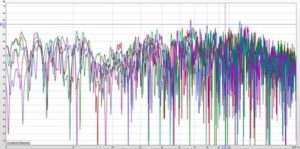Audiofrog tech blog

Crossover Slopes and Protection for Speakers: Does a Steeper Filter Provide More Protection?
Someone asked recently about choosing a crossover slope and asked, specifically, if using a 48dB/octave crossover would provide better protection than a 24dB/octave slope. I usually recommend 24dB/octave Linkwitz Riley

How to test for polarity
Fyi for those of you who have this polarity tester: the tester works fine, but pulses on the CD are not long enough to allow you to get a polarity

Dispersion and reflection
I’ve posted this graphic a thousand times and other people have grabbed it and posted it 10,000 times. Maybe there should be some additional explanation because although most of us

Testgear UMi-1 includes a CD with tracks designed for listening
I keep getting accused of suggesting a process for tuning a car that doesn’t include listening to the car and making any additional adjustments. This is ridiculous. How do I

Are scopes and sine waves useful when setting up DSP?
I’ve done a couple of KFest presentations about setting gains in new systems and suggested that all of this scoping and 0dB sine waves aren’t all that useful in a

A Note about Target Curves
Just a little note here about target curves. The black target curve is the Audiofrog target curve. Some people call this the “Harman” target. That’s because I used to work

Crossovers: How They Work and How to Choose Them
There are lots of choices and even more opinions about which crossovers are the best. Arguments for and against the various slopes and alignments often include all kinds of crazy

Measuring Frequency Response: Single Mic or Multi-Mic Average?
I’ve written a tuning process with some additional explanations. You can download that document on the Testgear section of this site. It’s called “A Straightforward One Seat Tuning Process and

Time Alignment Part Three: Delays and Crossovers for Tweeters and Mids
In part two, we discussed comb filtering and how it affects both frequency response and imaging. Comb filtering is caused when two sources of the same sound are different distances

Time Alignment Part 2
Yesterday, we covered a little bit about digital audio basics. For more on that, see the tech tip by that name here. We also covered, in a basic sense, how

Time Alignment Part 1
After reading a lot of Facebook posts about time alignment settings and after a couple of tech support calls last week, I decided I’d Google “how to set time alignment”.

Damping Factor and Why it isn’t Much of a Factor
Few specs are as poorly understood as amplifier damping factor. The suggestion in the spec is that the closer to a short circuit the amplifier’s output appears to the speaker,

Tech Tip: Digital Audio Basics
I’m seeing a lot of posts about high resolution and people switching DSPs for models with ever increasing sample rates and bit depth… I also see this graphic everywhere and

To Cap or Not to Cap? Tweeters in Systems with Active Crossovers
Lets say you park your car on a hill. Let’s also say it’s a standard transmission, and you leave it in gear. It should be there when you return, right?

Pink Noise, White Noise and Why Your Tweeters never get 150 watts
What’s the difference? I’ve always read and been told that “White noise is equal energy at every frequency and pink noise is equal energy in every octave”. What does that

Is it okay to use the terminal screw to crimp a ferrule?
Someone just mentioned to me that there’s a new way to use ferrules touted by some industry influencers–specifically, that the proper installation of ferrules over wire is to slide them
